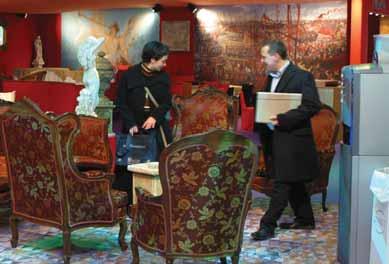
3 minute read
Dickson Coatings focuses
from Raven Issue No. 1

Matthew Watson, general manager of Dickson Coatings, insists that the company’s list of research and development projects fits on a single sheet of paper. This disciplined approach is challenging for a company such as Dickson with R&D labs and a team of research specialists.
Advertisement
“There was a time when we pursued every impossible idea that our salesmen brought to the table, but no more,” Watson said. “We select priorities carefully and limit ourselves to no more than five major development programs atone time. Our approach is disciplined, based on market potential and competitive advantages.”
Watson’s disciplined approach to technical fabrics development appears to be paying off as evidenced by products and markets with significant growth potential – release liners for tires, printable fabrics and protective garments for extreme heat and cold.
“We have the potential for increasing our sales by 50 percent over the next three to five years without any significant investment,” Watson said. “Our mentality is that of a start-up company – that we have something fresh to offer our customers.”
One of the most recent examples of this start-up mentality at Dickson Coatings is release liners for the manufacture of tires – a laminated fabric used to store freshly extruded rubber to protect it and assure that it doesn’t stick to itself. Dickson is marketing the product throughout Europe and North America, achieving a 78 percent increase in sales overthe past year. The “release liners” business has grown from 10 percent to 30 percent of Dickson PTL’s total sales in the past three years.
Primary customers for release liners are Michelin, Goodyear, Bridgestone, Pirelli and Continental, serving all of Europe, North America, South America, Russia, China, India, Pakistan, Africa and soon Japan. The newest development is a release liner for Formula 1 race car tires, which are extremely tacky and difficult to handle.
“While other release liners on the market just happen to work with rubber, our release liner was designed specifically for that purpose, which means it lasts longer and performs better,” Watson said.
This same value proposition – better performance from fabrics tailored for a specific end use – is also the secret to success of Dickson Coatings printable fabrics, which are used in upscale retail and commercial locations. Marketed under the brand name “Evergreen,” Dickson’s Jet Tex fabric media not only offers high levels of print clarity, but is also environmentally friendly. Unlike vinyl, Dickson Evergreen fabrics are free from PVCs and heavy metals and require 80 percent less energy during manufacturing.
“Our Evergreen fabrics are very popular with high-end retail companies that not only appreciate the print quality, but also support the environment,” Watson said. “Some of the leading brands using our fabrics are Cartier, Louis Vuitton, Diesel, Nike, Starbucks, BMW, Apple and Levis.”
The Evergreen product line has been so successful in Europe that Dickson Coatings opened an office in Atlanta to target the North American market for fabric media. After three years of operations, this office is selling $1 million annually of eco-friendly media fabrics. The Atlanta office will soon be selling a third new product line from Dickson Coatings – apparel fabrics for protection from extreme heat and cold.
“A few years ago, we were asked to look into a replacement fabric for leather firemen’s gloves,” Watson said. “Quality leather is getting difficult to find, plus leather becomes stif f and shiny when dry and soggy and uncomfortable when wet.”
The result was an aramid knit fabric with a silicon coating that, when fabricated into a poncho, can protect a fire fighter for up to 15 minutes at 900 degrees centigrade. Dickson Coatings has developed prototypes of the fabric in gloves and ponchos and is marketing them throughout Europe. The gloves serve as a replacement for leather, offering better grip, more dexterity and improved comfort.
On the other extreme of protective apparel – extreme cold – Dickson Coatings has created an offering of knittedc otton fabric with a silicon coating. This fabric, ideal for healthcare settings that involve cryogenics, provides protection at temperatures as low as -200 degrees centigrade. Again, Dicksonis marketing prototype gloves and clothing.
“We are very creative when it comes to the development of textile products,” Watson said. “Our reputation in Europe is for quality products and services with highly technical fabric solutions. We are positioned for growth in North America and around the world.”



